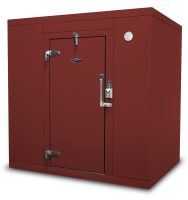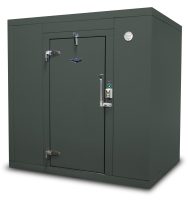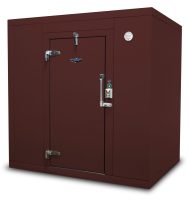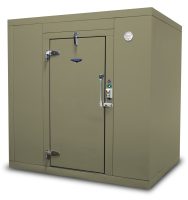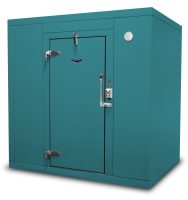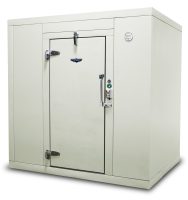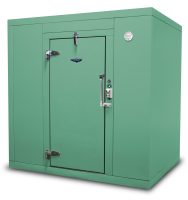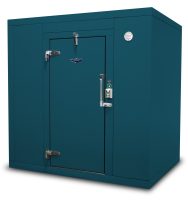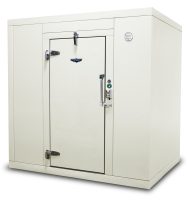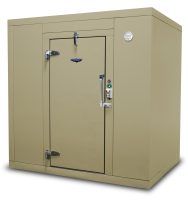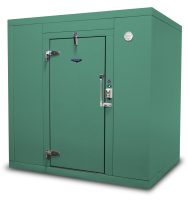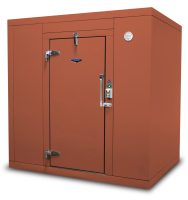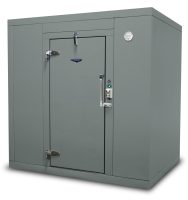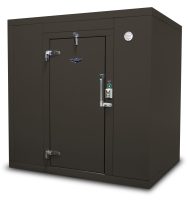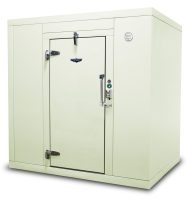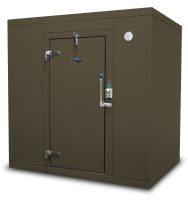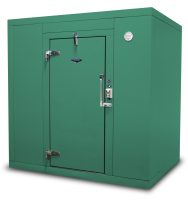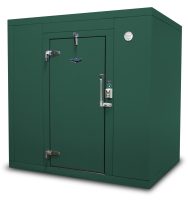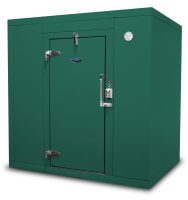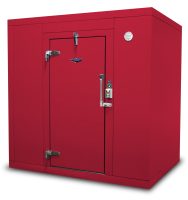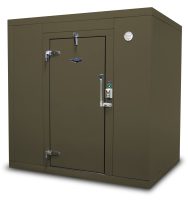When deciding on which walk-in cooler or freezer to buy, many things must be considered. In the following guide, we will go through all these considerations and provide you with the information you need to make an informed decision.
Buying Guide
WHAT IS IMPORTANT TO YOU:
Most walk-in coolers and freezers manufactured today are constructed of foam insulation bonded between two pieces of sheet metal and come equipped with cam locking devices to allow the assembly of the panelized walk-in on site.
There are a few companies that also provide a completely assembled unit that is delivered on a truck and dropped off at your location. These are usually for outside the building installations. Refrigeration systems are also usually provided in several types of configurations along with the walk-ins. These systems will be explained later.
When considering the purchase of a walk-in you should look for the following:
- A walk-in that will keep your product at the desired temperature, whether cooled or frozen.
- A walk-in that can be installed quickly and professionally and not have delivery and installation problems that can negatively impact your business.
- A walk-in that is easy to use. The door should be easy to operate, and the temperature and light switch easy to use.
- A walk-in that uses as little energy as possible to get the job done and keep your product at the desired temperature.
- A walk-in that lasts a long time without structural problems or degrading door, insulation, or metal problems.
- Once the above are met, you want to spend as little as possible to buy, install and operate your walk-in.
What you want is value in your walk-in purchase. Make your decision based on your needs and not what someone is trying to sell you. All customers’ needs are not the same; one product does not fit all.
MATERIALS:
INSULATION MATERIALS:
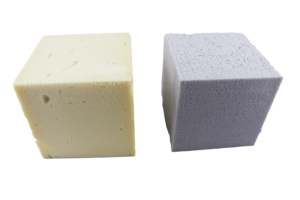 Since the implementation of the new Energy Independence and Security Act of 2007, which was implemented on January 1, 2009, there are two insulation materials in the manufacturing of walk-in Coolers and Freezers: Extruded Polystyrene and Foamed-In-Place Polyurethane. Each insulation is constructed of gas-filled cellular plastic foam and each option brings with it different benefits to the customer.
Since the implementation of the new Energy Independence and Security Act of 2007, which was implemented on January 1, 2009, there are two insulation materials in the manufacturing of walk-in Coolers and Freezers: Extruded Polystyrene and Foamed-In-Place Polyurethane. Each insulation is constructed of gas-filled cellular plastic foam and each option brings with it different benefits to the customer.
- Extruded Polystyrene –This insulation is also used to insulate underground concrete foundations and floors. It has a high initial R-value (R-32), and has great moisture resistance, and the ability to retain around 47% of its R-value (or R-15) over the life of the product. If overall performance is considered, extruded polystyrene is the ideal insulation for walk-in coolers and walk-in freezers.
- Polyurethane –Polyurethane is, among many other things, used as packaging foam and in the construction of outside walk-through residential and commercial doors. It has a high initial R-value (R-32) but is less capable of moisture resistance and R-value retention. It can only retain around 19% of its initial R-value (or R-6) over the life of the product. It is a good insulation for manufacturing products that include intricate parts that need to be bonded together. Polyurethane has been successfully used in the manufacturing process of walk-in coolers and freezers for many years.
Metal Skins
Walk-ins come with several different types of skins, depending on what the customer desires. Each of these skins provides different benefits.
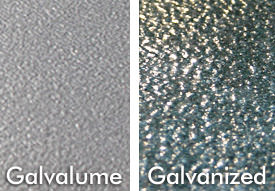
1. Galvalume –Galvalume is steel coated with a combination of aluminum and galvanizing material. It has the strength of steel but is twelve times more resistant to corrosion than galvanized. It is usually provided in a 26-gauge minimum thickness and is a gray color that is usually embossed to make it look more appealing. It is generally less expensive than aluminum, stainless steel, and G90 galvanized. If you’re looking for value, it is the product of choice.
2. G 90 Galvanized Steel – This metal used to be the most popular choice for walk-ins, but with its exorbitant increase in price, it has lost popularity. The G90 depicts the type of galvanizing it has, with G60 having less resistance to corrosion than G90. G90 is the minimum needed in producing a walk-in cooler or freezer. It used to have the advantage of being reasonably priced but has since become sensitive to price fluctuations. The material is strong and more dent resistant than aluminum. Another disadvantage to this metal is that it can develop “white rust” if it is not handled correctly in installation and/or if caustic cleaners are used. Once white rust has formed, it can turn into red rust if not treated. G90 can be stucco embossed, making it even stronger while also giving it an embossed look that is sometimes desired in the market. G90 is usually provided in 26-gauge minimum thickness for walls and ceilings and a 16–20-gauge thickness for floors. Note that G90 Galvanized floors are not approved for manufacture by the National Sanitation Foundation for food service applications. They can, however, be used if quarry tile is installed over the floor before use.
3. Aluminum – Aluminum as a raw material is more sensitive to price fluctuations. It is very resistant to corrosion, except when in contact with salt spray. It is not as strong as other metals and can dent very easily. Aluminum is usually provided in 40-60 mill thickness for walls and ceilings and 100-120 mill thickness for floors. Aluminum floors can be made 1/8th-inch thick and diamond tread-plate embossed to add further strength. When aluminum is used for walls and ceilings, it can be stucco embossed to increase its strength.
4. Painted G90 Galvanized – Painted galvanized is more expensive than Galvalume but is more resistant to corrosion and has the benefit of providing a choice in color for customers who want the painted look. The paint system used on the walk-in must be approved by the NSF.
5. Stainless Steel – Stainless steel is the most expensive of all metal skins that are normally used in walk-in construction. It is the strongest and least corrosive of all the metals and usually comes in 24 or 22-gauge thickness. It comes in different finishes, such as brushed and polished. Most walk-in coolers come with a brushed look to reduce the visibility of scratches.
Deciding on which skin you desire depends on what features are important to you.
METAL COLORS:
U.S. Cooler® now offers over 20 different smooth metal colors for the exterior of your next walk-in. When designing your project, you can now style your walk-in to blend in or become the focal point of your room.
Click on the walk-in in the selected paint color to view larger.
Graphically simulated-color may vary from actual metal color.
There is an additional charge for designer colors.
REFRIGERATION SYSTEMS:
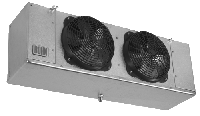
Refrigeration systems consist of a condensing unit and a unit cooler. The condensing unit is located outside the walk-in, and the unit cooler is located inside the walk-in. The compressor works to compress gas into a liquid. That liquid is then pumped through the condensing unit coil while a fan blows outside air through the coil. Gas is condensed to a liquid and is then pumped through a pipe into the walk-in to the unit cooler. There, through the expansion valve located in the unit cooler, the liquid can expand back into a gas. The expansion of the liquid to a gas causes a rapid chilling of the evaporator coil. Inside the walk-in, since heat always flows towards cold, air is blown across the evaporator coil to let the coil absorb the heat. The gas is then allowed to exit the walk-in through a larger pipe to the condensing unit, where it is once again compressed and cooled to a liquid state and returned to the unit cooler inside the walk-in. Then, the cycle restarts.
The new EISA law requires all new walk-ins to be equipped with high-efficiency motors to be compliant. These cost more but save you money in the long run. Some suppliers may try to sell you non-EISA compliant refrigeration systems. To be compliant with the law and purchase the best lifetime value always ask for EISA-compliant equipment.
1. Remote Systems – Remote systems are the least expensive systems to purchase. They consist of a condensing unit, unit cooler, and miscellaneous parts such as an expansion valve, sight glass, a dryer, pump down solenoid, and thermostat, all for installation into the system. For freezers, a timer and drain line heater are also included. These systems provide an advantage by allowing the condensing unit to be located outside the building. This means that the condensing unit can dump its heat there without adding extra heat to the building and air conditioning systems. Remote systems do require the use of a licensed refrigeration installer, as the systems are pumped down and charged with refrigerant gas on site. The installer will also charge for any other parts needed for the installation, such as copper pipe, pipe insulation, connectors, and electrical. Remote systems are less expensive systems to buy with the walk-in, but they may cost more overall depending on the hourly rate of the installer and the cost of the parts they provide.
2. Pre-assembled Remote Systems – Pre-assembled Remote Systems, are the same as Remote Systems except all the parts are shipped and installed on either the condensing unit or the unit cooler. Pre-assembled Remote pre-charged systems come with the condensing unit, the unit cooler, and the line set (copper pipes that connect the two units) charged with refrigeration gas. A licensed refrigeration technician will be needed to install the refrigeration system. These systems may or may not be less expensive depending on the cost of the system, the refrigeration service, and electronics service charges.
3. Saddle Mount Refrigeration Systems – Saddle Mount Refrigeration Systems come completely pre-assembled on a bracket that is designed to be mounted over the top of one of the wall panels. These systems must be installed on a panel with slots cut in the top to allow the bracket to go through the wall and must be hung before the installation of the roof. These units also have the unit cooler hanging from the top of the panel so that it doesn’t interfere with any shelving. A licensed refrigeration technician will not be needed to install the refrigeration system.
4. Penthouse Refrigeration System – Penthouse Refrigeration Systems do not have a unit cooler sticking down inside the walk-in. The air inside the walk-in is drawn up through the evaporator coil located with the condensing unit to be cooled. The condensing unit is located on the top of the box, meaning proper height will be needed above the walk-in to be installed and operate correctly. The unit needs proper airflow to prevent overheating. These systems sometimes seem higher in upfront cost, but when all things are considered, including the fact that they are factory assembled and do not take up space inside the walk-in, it is less expensive in the long run. A licensed refrigeration technician will be needed to install the refrigeration system.
Whatever the refrigeration system you chose, it is important to check the efficiency of the unit and the manufacturer’s warranty before you make your final choice.
The key to determining the proper refrigeration load requirement for any box rests on two general items:
- Product load or internal heat load – This would include any incoming temperature of the product being stored, the heat of respiration of the product being stored, any change of state of the product (freezing), and any heat given off by lights, motors, people, etc.
- External load – This would include any air infiltration load, radiant load through walls, ceiling, floors, door openings, etc.
Ambient temperature or ambient temperature difference from external box temperature to internal box temperature can have a significant impact on the load required.
On walk-in coolers, for example, the difference in wall and infiltration loads from an 80°F ambient to a 90°F ambient is approximately 18-20%. From an 80°F ambient to a 100°F ambient, that difference increases as much as 30%. See table 1.
Table 1
Data from Russell’s Engineering Manual

Table 2
Data from Russell’s Engineering Manual

In all cases, the refrigeration technician should use proper sizing tools such as the Russell Engineering manual RU-ENG-0313A to determine the proper load requirements.
Source: HTPG Tech Note February 2019
OUTDOOR APPLICATIONS:
Cooler and Freezer refrigeration systems that are installed outdoors require a winter kit. This kit provides a compressor cover, a crankcase heater to keep the oil in the compressor warm and operating properly in cold weather, and a fan cycle or head pressure control to keep the head pressure at the proper levels.
Outdoor Coolers and Freezers need to have a rain roof installed to prevent water from leaking into the box. A rain roof can be made of a single membrane polyester polyvinyl, chloride roof system with connectors and a drip cap for the door, or it can be metal flashing that installs over the roof seam to prevent water from leaking into the box.
WALK-IN COOLERS AND FREEZERS WITHOUT A FLOOR
Walk-in coolers and freezers sometimes come without a floor. Special precautions need to be taken to eliminate future problems that may occur. Walk-in coolers and freezers without a floor must be installed on a ground contact concrete floor. A cooler can be installed without insulating the floor and a thermal break under each wall panel, but we recommend installing both. A freezer must be installed on an insulated concrete floor and must include a thermal break under each wall panel. To see the recommended example of a concrete pad for a walk-in, check out this cooler drawings pdf.
An engineer or architect in your area will be required for the final design of your pad to meet local code approvals. If these precautions are taken, you should have a trouble-free performance with your walk-in floor.
MANUFACTURER:
No matter what walk-in system you buy, one of the most important decisions is deciding which manufacturer to purchase from. There are many manufacturers of walk-in coolers and freezers, and they all have their niche in the walk-in industry. The amount of service they offer the end user varies.
Look for a walk-in company that has these traits:
- The company should have been in business for at least ten years.
- They should have a good website explaining the items they offer and information about the company.
- The company should answer the phone with a person, not an answering device. Answering devices are for their convenience and not yours. Should you call, you should always be able to talk to someone.
- They should have clear quotes with an itemized list of the items provided.
- They should be highly informative and pleasant on the phone and treat you with interest and respect.
- Their location and shipping cost need to be spelled out clearly. Shipping is an especially important item in figuring the upfront cost of the project.
- Check the warranty clearly so that you know what is covered should problems occur.
- Get references from other customers.
- Make sure they are National Sanitation Foundation and UL approved.
- The company should specify how the walk-in is manufactured with the types of materials used in its construction.
CONCLUSION:
Buying a walk-in cooler or walk-in freezer can be a big investment, so make sure you are completely informed before deciding what to get. Be careful to buy what you need and not what a salesperson is trying to sell you. Remember, you are the one that will have to live with the walk-in you choose. Good Shopping!


